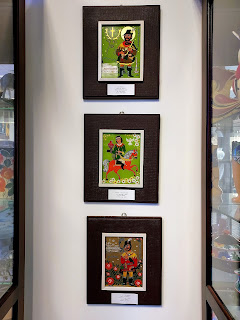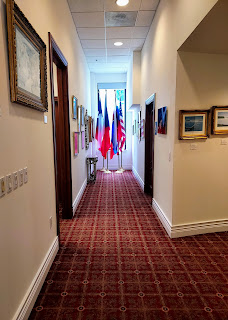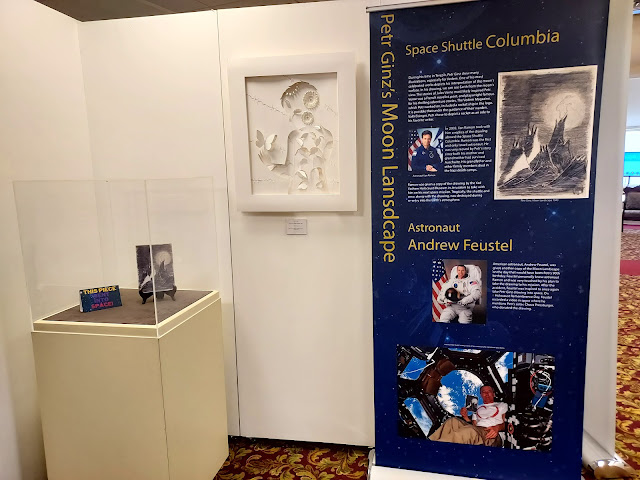

I had a hole in my conference day on Saturday that I used to visit the
Czech Cultural Center & Museum. The Lyft driver dropped me off in front of a large European-style building; the inside is decorated with thick carpet and Bohemian crystal chandeliers. Downstairs is a foyer and a gift shop manned by a kindly elderly gentleman. The "chapel" covers religious history such as Jan Huš (c. 1370-1415), while the Presidential Room has collections of ceramics, crystal, and portraits. Upstairs on the second floor are a ballroom, meeting room, and offices. There are paintings and photographs on the walls, flags in the front window, and art and education panels in the ballroom. The third floor is given over to exhibition space and the Comenius Library, named for
Jan Amos Komenský (1592-1670), who is celebrated as an educator. They must have a very large collection, as an intern was changing out some of the decorativeware while I was there. The Cultural Center hosts language classes and other events, including a parent-child group that meets on Saturday mornings.
On the altar are Catholic, Protestant, and Jewish Bibles. The stained glass is of course Czech.
The curator who met me at the door and was pleased to hear that I had Czech heritage told me the only presidents whose portraits she would "allow" in the Presidential Room were Tomáš Garrigue Masaryk (1850-1937), Edvard Beneš (1884-1948), and Václav Havel (1936-2011).
The classic blue-yellow-white ceramics.
They have both traditional and modern pieces. The blue and yellow tea set in the middle isn't easy to make out, but the sauces are shaped like the four suits in a deck of cards. I imagine it being used during a game night.
This collection of green glass objects were intended to look like jade.
Some of the artwork on the walls in the Presidential Room. The "Pittsburgh Agreement" creating the new Czechoslovakia was of course signed in my new hometown on 31 May 1918. I had not known beforehand that Masaryk had married an American woman, Charlotte Garrigue (1850-1923). They took each other's late names.
Down a narrow hallway on the first floor are images and placards about the Communist period, from the take over in 1948, the Prague Spring in 1968 that was put down in fall 1968, and the Velvet Revolution, with both photos and a 10-minute video. There was also this collection of small placards about art censorship during the Communist period.
There's a grand staircase to reach the second floor, with modernist art on the landing.
I particularly liked the green painting on the right, "Arrival of Immigrants" by John Pavlicek (1946- ).
This is the ballroom, where I imagine beseda lessons and fancy dinners.
Here's an educational panel about Czech Texans and dance; there are a number of pieces by Alphonse Mucha (1860-1939); and art by Czech and Czech-American artists of Czech and American subjects such as Kamil Kubik.
This is an unusual travel memento: an artificial rose preserved in the mineral waters of Karlovy Vary; after 2 weeks it collects argonite sediment called "thermal tuff."
Images of beloved Prague.
Vítáme vás ~ Welcome!
There's a little room set up like a humble abode--except for the crystal chandelier!
I really liked the brightly colored murals!
In this hallways there was also a flat-screen television with a slide show about the end of the Austro-Hungarian Empire.
A piano on the left, a puppet theater on the right, which reminds me of the marionettes that I bought on the Charles Bridge during our first trip to Prague in 1996. They also had some more recently artwork, including collages done by schoolchildren against racism and discrimination.
The temporary exhibit up right now is about the Holocaust and Terezin/Theresienstadt. This panel is about
a little boy's drawing of the Earth from the perspective of the moon. He didn't survive. A copy was onboard the
Challenger when it exploded. Another copy did make it up in space with a later astronaut. In between the panel and the case hangs a beautiful cut-paper artwork, "I never saw another butterfly."
More mirror-backed cases of beautiful objects.
They have many different
kroj on display. Most of the Czechoslovaks who immigrated to Texas were Moravian, so that is the emphasis. After perusing the gift shop, I walked down the street to a hopping Black vegan restaurant, where I had a nice "hash" named for Houston-born crooner Johnny Nash before taking a Lyft back to the conference hotel. It was such a nice break from sitting inside concentrating on academic discussions to spend a couple hours immersed in my heritage.



































No comments:
Post a Comment
Your comments let me know that I am not just releasing these thoughts into the Ether...